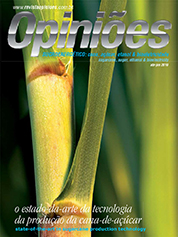Orivaldo Brunini
President of FUNDAG - Agricultural Research Support Foundation
Op-AA-24
Agro-meteorological progress and sugarcane culture
High demand for renewable energy sources, concern about the preservation of the environment and the production of food for the population - have placed countries around the world in a state of alert. Reports of the IPCC – Intergovernmental Panel on Climate Change show the trend towards global warming, with more effects in regions of medium and low latitudes, in which sugarcane is more intensively exploited commercially.
The world society and biodiversity have been exposed to such climate changes, with intensive effects on well-being. An important aspects of mitigating adverse effects on crop plantations is climate and agro-metereological monitoring, aimed at implementing rational agriculture and the management of irrigation, while preserving hydric reserves and springs, in view of the scarcity of hydric resources and the variability of precipitation, as well as the hydric need of the sugarcane culture.
Such conflicts need to be resolved with support provided through research and the adaptation of cultures, at the regional level, directed towards modern self-sustainable agriculture, in which climate factors, water and soil are managed in a balanced manner. Setting up a database of such essential elements is imperative for implementing agricultural policies aimed at the production of food and a self-sustaining agro- and bio-energy industry such as sugarcane.
The transference of metereological data, in real time, is a global need, to support a variety of research activities. Seventy percent of the adversities and impacts of natural disasters are directly related to metereological aspects. Concern about such phenomena has grown considerably, resulting in the setting up of strategies and proactive and effective measures to monitor metereological variables, involving systems and net-works to collect and transfer data and to monitor and diagnose metereological elements, according to rules and criteria laid down by the World Metereological Organization.
With the progress achieved in developing sensors and data acquisition systems, the monitoring of environmental variables reached a high degree of quality and reliability. This has led to the creation and installation of a network of automatic metereological stations in several countries, bringing about actual benefits for agriculture.
Along this line, the Secretariat of Agriculture of the State of São Paulo, through the Agribusiness Technology Agency of the State of São Paulo and the Agronomical Institute of Campinas, is developing technologies and products to support the sustainable agricultural exploitation of sugarcane, along with the technical and logistical support of FUNDAG – Agricultural Research Support Foundation.
Of these products and technologies four should be highlighted due to their technological span and dimension. The first, directly involving the sugar and ethanol industry, consists of automatizing the metereological network management, with the installation of state-of-the-art sensors to monitor variables throughout the State of São Paulo and in several other states.
This information is accessible online in the site www.ciiagro.org.br/ema/monitoramento.php It serves to immediately support users in analyzing and practicing agricultural and environmental management, for example, involving air temperature, pluviometric precipitation, solar radiation, wind, and ground temperature. Nowadays, 84 locali-ties are monitored in the State of São Paulo.
By June of this year, 20 new units will have been installed. A second aspect to be mentioned is the work being developed by CIIAGRO – The Integrated Agro-metereological Information Center, where daily information about 150 localities in the State of São Paulo is analyzed and processed and shown online in the site www.ciiagro.sp.gov.br, with support for soil preparation, planting, harvesting, and management of agro-chemical products – totaling more than 80,000 hits per month.
Another site worth mentioning is www.infoseca.sp.gov.br, with about 100,000 hits per month, which provides information, from metereological adversities to agro-meteorological problems, assessed from the climate and phythotechnical viewpoints, generating details about risks of dryness and high temperatures. Dryness indices are adopted considering the metereological and agro-metereological viewpoints, the phase the culture is in, and the type of soil.
Projections of the hydric balance on a future scale of up to 20 weeks are possible, generating the culture’s behavioral scenarios as a function of the prognosis on the climate. A more recent technology, developed in partnership with the Secretariat of Agriculture and Supply of the State of São Paulo and the Secretariat of the Environment, proposed an agro-environmental zoning for the sugar and ethanol industry.
This initiative may quantify climate risks and the necessary environmental actions to exploit the culture in terms of agriculture, allowing preserving the environment, soil characteristics and minimizing of climate risks. It was conducted to assess metereological and soil data of 430 localities in the State of São Paulo, furthermore incorporating aspects related to environmental connectivity and biodiversity preservation in the so-called Biota Project.




